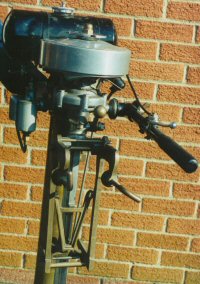Usually these are described as an 'SD' which of course is a wartime serial, from 1942-1946.
This one currently on offer is a case in point:

There is, up on the crankcase nose, a very clear 'SD', and that is what has misled the vendor. These letters appear on lots of crankcases, sometimes 'SD' sometimes 'SN' and other codes appear too; none of them are serial letters, and they don't identify the model.
The serials you're looking for appear on the crankcase base, adjacent to the driveshaft casing, like this one:

That one isn't an 'SD' of course, it's merely the only clear photo I could lay my hands on that illustrstes the position properly.
Many have been misled by this, and there will be many more, I suspect.
Wartime motors are:
SD/SDP; SN/SNP; and a few ON or OP models produced up to 1941 may have been bought by the military
A real wartime motor, acctually made for the Ministry (assuming there's no number)should have:
A short water jacket block
A round tiller arm lug
An early 'domed' Villiers magneto (AKA 'Coolie hat')
An Amal carb with some brass/bronze fittings
Either a cast bronze/brass universal lug for a transom bracket or a bronze skeletal bracket like this one:

That's British Seagull's example. Interesting that it has an earlier tank..
Oil nipples on the gearbox
A two blade swept-back prop
Plain gearbox end cap
Flat 'straight out of the back' exhaust
Probably a steel tank with a bayonet filler cap to the side, some later ones may have had brass tank with bayonet cap.
Probably a zinc coated driveshaft casing, some later ones plated
Probably a plain brass exhaust, some are plated.
May have a copper domed magneto cover, some are aluminium
As with everything Seagull there are of course variations, and it must be said that the skeletal bronze bracket I have described is scarce. We are still rather unsure as to what sort of bracket was issued to the military, there were lots of strange attachments made for them to strap the motors onto all manner of things.
They made over 10,000 of these for military use, there are quite a few survivors. An original one with all its original bits is worth having, and they crop up occasionally on the Bay, usually not expensive. One of the best bits about collecting these motors is that they are cheap!
Hope that helps.
Oh, the one at the top of this post. It's advertised as a wartime motor, but the eagle eyed will have spotted the signs. The Wipac magneto means post 1967, enough said. I managed to miss that originally, but the other Charles pointed out the error of my ways.
I don't blame vendors for what is, I feel an honest and understandable mistake. It's not like the motor advertised as 'perfect working order' on the Bay at the moment, where you can see the HT lead neatly parted in the middle where it's been wrenched out of a suppressor. The feature is described as a safety cutout.